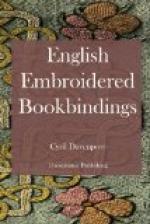It is a small copy of the Epistles of St. Paul, printed by Barker in London, 1578, and measuring 4-1/2 by 3-1/2 inches, and it belonged to Queen Elizabeth. Inside she has written a note in which she says: ’I walke manie times into the pleasant fieldes of the Holy Scriptures, where I plucke up the goodlie greene herbes of sentences by pruning, eate them by reading, chawe them by musing, and laie them up at length in the hie seat of memorie by gathering them together, so that having tasted thy swetenes I may the less perceive the bitterness of this miserable life.’
The Rev. W. D. Macray, in the Annals of the Bodleian Library, says, ’This belonged to Queen Elizabeth, and is bound in a covering worked by herself’; and the Countess of Wilton, in the Art of Embroidery, says, ‘The covering is done in needlework by the Queen herself.’
It is also described by Dibdin in Bibliomania. He says, ’The covering is done in needlework by the Queen herself.’
The black velvet binding is much worn, and has been badly repaired. The work upon it is all done in silver cord or guimp, and the designing, as well as the work, is such as may well have been done by the Queen.
On both covers borders with legends in Latin, enclosed in lines of gold cord, run parallel to the edges. Beginning at the right-hand corners of each side, these legends read, ’Beatus qui divitias scripturae legens verba vertit in opera—Celum Patria Scopus vitae XPUS—Christus via—Christo vive.’ In the centre of the upper side is a ribbon outlined in gold cord, with the words, ‘Eleva sursum ibi ubi,’ a heart being enclosed within the ribbon, and a long stem with a flower at the top passing through it. In the centre of the lower side a similar ribbon with the motto, ‘Vicit omnia pertinax virtus,’ encloses a daisy, a badge previously used by Henry VIII. and Edward VI., probably in memory of their ancestress, Margaret Beaufort. Both these inner scrolls have the initial letter E interwoven with them.
[Illustration: 23—Christian Prayers, etc. London, 1584.]
There is no doubt that the usual royal embroidered bindings of the time of Elizabeth were elaborately designed and richly worked, in decided contrast to this small book; and this difference of style makes it more probable that the Queen worked it herself.
There is no resemblance between this book and the two canvas-bound books already described which are attributed to her, except the use of cord alone in the embroidery; but the difference of material might perhaps be considered sufficient to account for this. No real evidence seems to be forthcoming as to the authorship of the embroidered work, but there is no doubt that the book was a favourite one of Queen Elizabeth’s, and if the needlework had been done for her by any of the ladies of her Court, it would be likely that she would have added a note to that effect to the words she has written inside.




